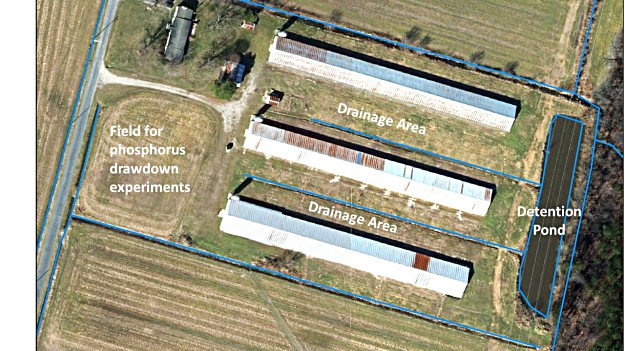
PRINCESS ANNE, MD- (August 24, 2020)- Meeting the challenge of sustainable reductions in phosphorus loads to the Chesapeake Bay is the goal of a new Stormwater Management Research facility at the University of Maryland Eastern Shore. A $300,000 Capacity Building Grant by the National Institute of Food and Agriculture was recently awarded to UMES researchers to “implement, monitor and evaluate nutrient-reduction strategies near poultry facilities,” particularly older ones.
“Growth in broiler production has led to a significant increase in the construction of poultry houses over the past five years,” said Dr. Amy Collick, an assistant research professor in the Department of Agriculture, Food and Resource Sciences at UMES and principal investigator on the project. “Modern poultry houses must meet critical site requirements and have approved stormwater drainage plans, however, many older houses did not have these requirements when they were constructed and are still in operation today.”
The facility will serve as a training site where applied research will be conducted to study stormwater approaches for poultry housing facilities and demonstrate them together with the nutrient loss reduction to the adjacent landscape and waterways, Collick said.
Existing poultry houses on the UMES Teaching and Research Farm will be upgraded with the required stormwater conveyance features established most recently, such as vegetated disconnection areas, grass swales, wetland forebays and detention ponds. Research activities including deep tillage, boundary installation of permeable barrier filters, phosphorus binding material application and recovery will be conducted in adjacent fields. Protocols to compare soil phosphorus and water quality levels before and after installation of the approaches will be followed and implemented. Workshops will be held to bring together poultry integrators, drainage management experts, faculty and student researchers to develop innovative approaches to reduce phosphorus loss from poultry house stormwater systems.
Basic water, soil and sediment characteristics will be analyzed in the Agriculture, Food and Resource Sciences Department’s nutrient management and water quality lab. Nitrates, total nitrogen and different forms of phosphorus analyses for both water and soil will be sent to the USDA-Agricultural Research Station Pasture System and Watershed Management Research Unit to assess the nutrient contributions of poultry houses and effects on water quality.
The final step is a special analyses of new and older poultry houses and their location relative to drainage networks identified by a Geographical Information System analysis of Somerset County, Maryland.
“The drainage networks to and from farms participating in the study in the county will be digitized to determine the waterways impacted by potential point sources,” said Tracie Bishop, GIS program manager at the university. “A database of stormwater drainage characteristics around different poultry housing systems collaborating with our project will be catalogued to determine different drainage site conditions that would need to be explored during applied research studies at the facility.”
According to Collick, the analysis will be “beneficial to watershed modeling tools that can be used to track phosphorus transport.” It will include fine resolution ortho-imagery, topography, land use, soils, county farm information and statistics from sources such as soil and water conservation districts, local USDA-NRCS and Farm Service offices and the Delmarva Poultry Industry.
Existing hydrological, soil and water quality monitoring datasets on the agricultural land and poultry house facilities on the UMES Farm will be compared to those from participating farms and other available data, Collick said. Monitoring datasets will be developed that include groundwater, ditch and stream monitoring, soil characteristics, field management and subsurface imaging.

Outcomes of the research will be incorporated into teaching, extension and outreach in order to mitigate nutrient losses from point sources associated with poultry production. Other researchers involved in the project include Drs. Jennifer Timmons, an assistant professor at UMES; Ray Bryant, a soil scientist at USDA-ARS; and Zachary Easton, a professor at Virginia Tech.
This work is funded by the USDA Capacity Building Grant Program, Grant No. 2019-03222, from the National Institute of Food and Agriculture.
Top:
The drainage ditch area between poultry house systems is shown.
Above right:
The potential site of the stormwater facility on the UMES Research and Teaching Farm is depicted with an outline of the drainage networks (blue lines), locations of fields, drainage area and detention pond study sites.
Gail Stephens, agricultural communications and media associate, School of Agricultural & Natural Sciences, University of Maryland Eastern Shore, 410-621-3850, gcstephens@umes.edu.

